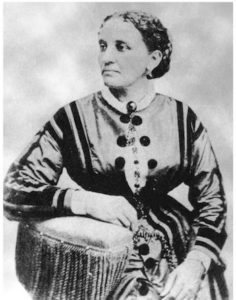
Elizabeth Keckley
On this date, we celebrate the birth of Elizabeth Keckley in 1818. She was a Black domestic, author, and abolitionist.
Born at the Dinwiddie Court House, Virginia, she was a dressmaker, seamstress, and personal maid to President Abraham Lincoln's wife, Mary Todd. Elizabeth Hobbs Keckley was a daughter of Agnes, a slave of the Burgwell family, and George Pleasant, who was owned by a man named Hobbs. When she was in her teens, the Burgwells sold her to a slave owner in North Carolina, by whom she was raped and had one child, George. Shortly thereafter, a Burgwell daughter, Anne Burgwell Garland, bought her and her son. They were taken to St. Louis, where Hobbs married James Keckley. She later found he had deceived her by claiming to be a free man, and the couple separated.
To support her owner's household, Keckley worked as a seamstress. She acquired many loyal customers, one of who loaned Keckley $1200 to buy her freedom in 1855. In 1860, she relocated to Baltimore and then to Washington, D.C., where she opened a successful dressmaking business and set a goal to become a seamstress at the White House. Keckley’s dream was realized after President Abraham Lincoln's wife, Mary Todd, recognized not only Keckley's talent for dressmaking but also her quiet and good-natured personality and hired her as a personal maid and dressmaker. Keckley also became the first lady's close friend and traveling companion. The two shared a common sorrow in the loss of their sons; George died in August of 1861, fighting for the Union army, and Willie Lincoln died a year later in 1862.
In 1862, Keckley established the Contraband Relief Organization, an organization of Black women who assisted former slaves seeking refuge in Washington, D.C. In addition to moral support, Mary Todd Lincoln donated $200 to the organization; donations were also received from Frederick Douglass and Wendell Phillips. When President Lincoln was assassinated on April 14, 1865, Keckley consoled Todd. In 1867, to raise money for the First Lady, Keckley helped her to auction off her clothing in New York, which later led to the scandal. In another attempt to generate funds for Todd and her, Keckley published her diaries in 1868, "Behind the Scenes; or, Thirty Years a Slave and Four Years in the White House."
Keckley recognized that this publication would invite criticism. However, she did not anticipate that the betrayal of her knowledge of the private lives and personal opinions of the Lincolns would elicit condemnation from Mary Todd Lincoln and great disapproval from the Black community. Because of this controversy, Keckley's business declined, and society ostracized her. From 1892 to 1893, she left Washington to teach domestic science at Wilberforce University in Ohio. She returned soon after to spend the rest of her days at the Home for Destitute Women and Children in Washington, which she had helped to establish. She died there from a stroke on May 26, 1907.
Because of Keckley's lack of formal schooling, the authorship of her memoirs is often questioned. Nevertheless, scholars uphold the information revealed in the book as an accurate source of information on her memories of the Lincoln White House.
Mrs. Lincoln and Mrs. Keckly: The Remarkable Story of the Friendship Between a First Lady and a Former Slave.
Jennifer Fleischner,
New York: Broadway Books. 2003